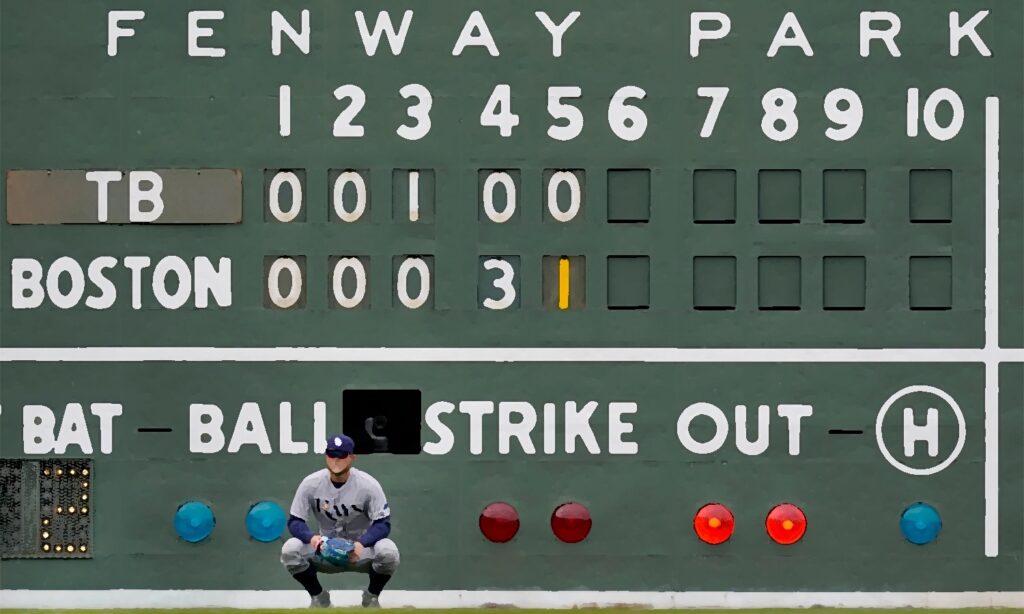Team sports are uniquely divided into various segments such as quarters, periods, and innings.
The most popular sports leagues in North America are the NBA, NFL, NHL and MLB. They respectively represent the game of basketball, American football, hockey and baseball.
For the most part, these leagues are governed by a game clock.
Both the NBA and NFL are made up of 4 quarters, twelve and fifteen minutes in length respectively.
The NHL is split into three periods, each 20 minutes long.
When it comes to Major League Baseball, games are divvied up into innings. But rather than a timer dictating the length of every inning, baseball uses a system of outs.
And before we go into detail, let’s answer the question you came here for…
How many Innings in Baseball?
There are 9 innings in a baseball game, each made up of six outs. The innings are split between the top and bottom half where both teams are given a chance at bat. Teams switch between fielding and batting every three outs.
The visiting team is always first to bat in each inning. And the home is always second to respond.
You’ll occasionally see games end midway through the 9th inning when the home team is winning.
That’s because the visiting has run out of innings to generate offense.
There’d be no point in the home team going to bat, since they’d only be able to pad their lead even further.
Similarly, you can witness the game end mid-inning. This can happen if either the game is tied or the home team was originally trailing in the 9th inning.
Should the home team capture the lead at any point, the game comes to a halt.
These plays are referred to walk-off runs.
How long does each inning last on average?
The typical baseball game will last 3 hours in real time on average.
With no game clock, the time variance is quite large with most games finishing +/- 30 minutes of the average.
So, the average inning is 20 minutes in length.
Unlike the other sports, there are no major breaks in baseball games. You could say that the fielding team gets a break when it’s their turn to bat.
That’s because most of the players will be sitting in the dugout, unless it’s their turn to bat, they’re on deck or already on base.
While on offense, you have five players active in any sequence at most. Three base runners, one batter at the plate and another warming up on deck.
The more you rotate through your batting lineup, the longer the inning will likely be.
But in most games, you’ll always have dry spells where the pitcher retires batters quickly.
Innings-Outs Relationship Explained
As mentioned earlier, innings are made up of 6 outs. Each team is granted 3 outs while at bat for the inning.
There are several ways the defending team can secure an out.
I provided a list for the most common outs you’d come across in a game. For an exhaustive list, see the following MLB blog post.
List of Common Baseball Outs
| Types of Outs | |
|---|---|
| 1 | Strike out |
| 2 | Popout |
| 3 | Line out |
| 4 | Ground Out |
| 5 | Thrown Out |
| 6 | Forced Out |
| 7 | Foul Ball Caught |
| 8 | Caught Stealing |
| 9 | Tagged Out |
In essence, outs can involve both the batter and the baserunners. The fielding team can also secure multiple outs in a single sequence.
These are known as double and triple plays.
Consider yourself lucky to witness a triple play, as it happens once in a blue moon.
On the other, the double play is quite standard game to game.
Let me explain the typical scenario:
With the runner on first, the batter hits a ground ball to the infield. The infielder throws the ball to their teammate covering second base for the out. That player proceeds to throw the ball to first base for the 2nd out.
You retire the side once the third out is secured. Regardless of if any players are left stranded on base.
Either the game proceeds to the bottom half of the inning or continues to the top of the next.
Can a Baseball Game last longer than 9 Innings?
Should the score remain tied after nine, the game will continue into extra innings.
In this scenario, the game goes inning by inning with each team given a chance at bat.
Once in extra innings, it’s a guarantee that the game will end at the bottom of an inning.
Extra innings apply both to the regular season and playoffs as tie games are no longer permitted in baseball.
A winner must be declared at the end of a game.
Most Innings Ever in a Baseball Game
The record for most innings in a baseball game dates back to 1920. The National League Boston Braves and Brooklyn Robins had to settle for a 1-1 tie following 26 innings of play.
Meanwhile, the longest game ever with a clear-cut winner happened in 1984.
The American League game involved the Chicago White Sox and the Milwaukee Brewers, which lasted for 25 innings.
The White Sox beat out the Brewers 7-6, which took a record 8 hours 6 minutes to complete.
Note that the MLB suspended the match to the next day due to a rule which doesn’t allow a new inning to start past 12:59am.
At the time, the score was tied 3-3 after 17 innings of play. The game resumed the following evening to completion.
Final Thoughts
As a baseball fan, I’ve always felt helpless when my team was fielding for the inning.
All I can imagine is my pitcher handing out homeruns or even grand slams like candy.
When you’re that committed to a team, you build a love-hate relationship with the players.
At least, when they were at bat, I never had to worry about the other team scoring and narrowing the gap.
As a note, I grew up watching the Montreal Expos.
There was not much to cheer on except for the 1994 squad, the Dennis Martinez perfect game, Pedro Martinez and Vladimir Guerrero.
Unfortunately, the 1994 season ended in a player strike with the Expos leading the league with a 74-40 MLB record.
That was the beginning of the end of this team in Montreal.
The team was eventually gutted of its stars and became a steppingstone for emerging players.
The final nail in the coffin was when the MLB announced that the Expos would move to Washington DC in 2005.






